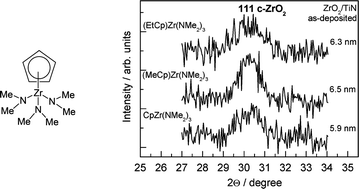Novel mixed alkylamido-cyclopentadienyl precursors for ALD of ZrO2 thin films
Abstract
Mixed alkylamido-cyclopentadienyl compounds of zirconium, (RCp)Zr(NMe2)3 (R = H, Me or Et) are introduced as precursors for

* Corresponding authors
a
Department of Chemistry, University of Helsinki, P.O. Box 55, University of Helsinki, Finland
E-mail:
jaakko.niinisto@helsinki.fi
b University of Tartu, Institute of Physics, Department of Materials Science, Tähe 4, Estonia
c Air Liquide Research & Development, 1 Chemin de la Porte des Loges, BP 126, Jouy-en-Josas, France
d Air Liquide Research & Development, DRTC, 200 GBC Drive, Newark, DE, USA
Mixed alkylamido-cyclopentadienyl compounds of zirconium, (RCp)Zr(NMe2)3 (R = H, Me or Et) are introduced as precursors for

 Please wait while we load your content...
Something went wrong. Try again?
Please wait while we load your content...
Something went wrong. Try again?
J. Niinistö, K. Kukli, M. Kariniemi, M. Ritala, M. Leskelä, N. Blasco, A. Pinchart, C. Lachaud, N. Laaroussi, Z. Wang and C. Dussarrat, J. Mater. Chem., 2008, 18, 5243 DOI: 10.1039/B810922B
To request permission to reproduce material from this article, please go to the Copyright Clearance Center request page.
If you are an author contributing to an RSC publication, you do not need to request permission provided correct acknowledgement is given.
If you are the author of this article, you do not need to request permission to reproduce figures and diagrams provided correct acknowledgement is given. If you want to reproduce the whole article in a third-party publication (excluding your thesis/dissertation for which permission is not required) please go to the Copyright Clearance Center request page.
Read more about how to correctly acknowledge RSC content.
 Fetching data from CrossRef.
Fetching data from CrossRef.
This may take some time to load.
Loading related content
